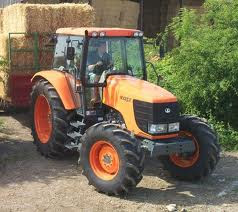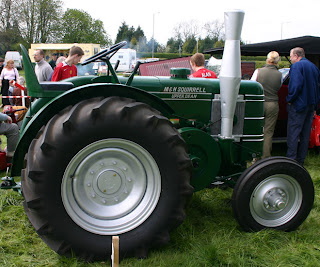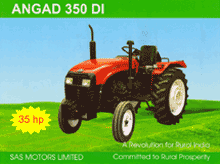Angad Tractors
SAS Motors Limited, the manufacturer of 'Angad' Tractors, is a public limited company incorporated in April 2003. Its flagship product is ‘Angad’ 240 D tractor. The company is engaged in sourcing, assembling, manufacturing, and marketing of ‘Angad’ brand tractors and farm machineries. SAS Motors also provides a range of agricultural equipments.
Angad Tractors (SAS Motors Limited) main mission is to make low cost tractors, power tillers, and other farm machineries designed on ‘appropriate technology ’ platform available to the Indian farmers.
Currently, SAS Motors Limited currently manufactures Tractors(ranging from 15-35 horsepower), Power Tillers, Mini Tillers / Power Weeders and Agricultural Machineries such as Rotavator etc.
Balwan Tractors
Formerly known as Bajaj Tempo Ltd. until 2005, Force Motors Ltd., makers of India's ubiquitous 3-wheeler Tempos since 1957 in a collaboration with Vidal & Sohn Tempo Werke, Germany. In 1999 began production of Ox and Ox 45 Brand Tractors both which incorporated transmission technology from the German manufacturer ZF. Additional line Balwan was introduced in 2004 and between the lines Force Motors offers a line of two-wheel and four-wheel tractors in a horsepower range from 10 to 50 HP In India BALWAN 600 launched shortly. It has a 60 HP engine. Balwan Tractors are one of the good tractors in India for agricultural purposes. They have a Benz engine.
Captain Tractors
Founded in May 1994 and located in Rajkot, India, Captain Tractors manufactures mini-tractors under the Captain brand.
Crossword Agro Industries
Located in Rajkot, India, Crossword manufactures small tractors under the Nissan, Atmak and Captain brand names.
Eicher
In 1949, Eicher GoodEarth, was set up in India with technical collaboration with Gebr. Eicher a of Germany, imported and sold about 1500 tractors in India. On April 24, 1959 Eicher came out with the first locally assembled tractor from its Faridabad factory and in a period from 1965 to 1974 became the first fully manufactured (100% indigenization) tractor in India. In December, 1987 Eicher Tractors went public and in June, 2005 Eicher Motors Limited sold Eicher Tractors & Engines to a subsidiary of TAFE called TAFE Motors and Tractors Limited.
Eicher also produced tractors under the Euro Power and Eicher Valtra brands under license from Valtra, an AGCO brand.
Escorts (Escort, Powertrac and Farmtrac)
Escorts Ltd began local manufacture of Ford tractors in 1971 in collaboration with Ford, UK and total production climbed steadily to 33,000 in 1975, reaching 71,000 by 1980. Ford (Ford - New Holland) was sold in 1992. Ford Motor Company proper quit the tractors business, but the name was allowed to continue as per agreement until 2000, when Escorts relabeled its Ford models under the Escort brand. Escort manufactures produces tractors in the 27-75 HP range and has already sold over 6 lakh tractors. Its tractors are marketed under three brand names, Escort, Powertrac and Farmtrac. The Escorts Group, is among India's leading engineering conglomerates operating in the high growth sectors of agri-machinery, construction & material handling equipment, railway equipment and auto components.
HMT Tractors
HMT is a large public sector unit and began manufacturing Agricultural Tractors in 1972 under the HMT brand name with technology acquired from Zetor of the Czech Republic. It manufactures its tractors in Pinjore, Panchkula in a large factory that also manufactures machine-tools, and Hyderabad It has a capacity of 20,000 tractors per annum. In the Machine-tool company is a large foundry. It produces tractors in a range from 25 HP to 75 HP. HMT has also exported tractors to the USA under the Zebra brand, which were marketed by Zetor distributors and dealers there. The company is controlled by the Ministry of Heavy industry that provides to the public its financial performance.
Indo Farm
Founded in Baddi, Himachal Pradesh, India in 1999, Indo Farms builds tractors in the 33 to 90 hp ranges. company is also manufacturing 9 to 18 ton cranes and 15 to 50 kv silent gen sets. ursus Poland is its technical partners. indo farm tractors are becoming famous in Indian tractor customers because of their better working performance, quality and resaonable prices. company is exporting their products to many developed countries like: New Zealand, uk, Poland, Germany etc. tractor manufacturing is fully computerised and marketing team is very dedicated and experienced.
John Deere
In 2000, John Deere set up production in a joint venture with Larsen & Toubro Ltd in Sanaswadi, in a rural area near Pune, Maharashtra. It was known as L&T John Deere Private Ltd, and manufactured tractors under the L&T - John Deere name for sale in India, and under theJohn Deere name for worldwide sales.
In 2005, Deere & Company acquired nearly all the remaining shares in this joint venture. The new enterprise, is known as John Deere Equipment Private Limited. The factory currently produces tractors in of 35, 38, 40, 42,45, 50, 55, 65, 75 and 89 HP capacities for domestic markets and for export to the USA, Mexico, Turkey, North and South Africa, and South East Asia. Pune factory started to produce new 55 to 75 Hp 5003 series tractors for European market in 2008.
John Deere India Private Limited is a subsidiary of Deere & Company, USA in India. Its factory, located at Sanaswadi, Pune, manufactures 5000 Series agricultural tractors. The Indian operations of Deere & Company include a technology center located at Magarpatta City Pune and John Deere Water Vadodara. The technology center provides services in the areas of Information technology, engineering, supply management, embedded systems and technical authoring for company’s operations world wide. John Deere Water, formed by the acquisitions of Plastro Irrigation Systems, T-Systems International, and Roberts Irrigation Products, is one of the leading irrigation companies in the world today.




















